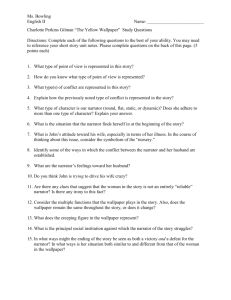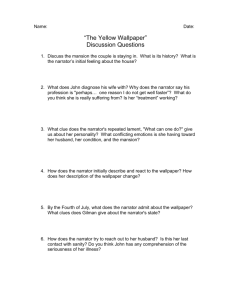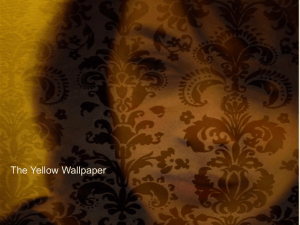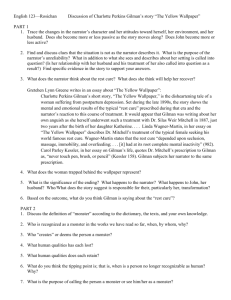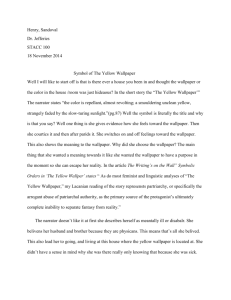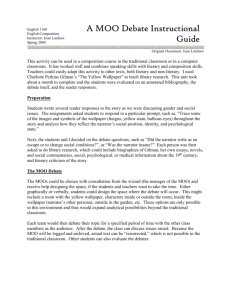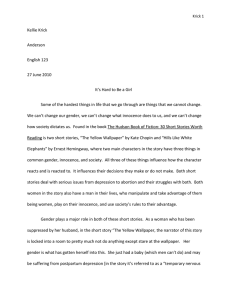Name - Edublogs
advertisement
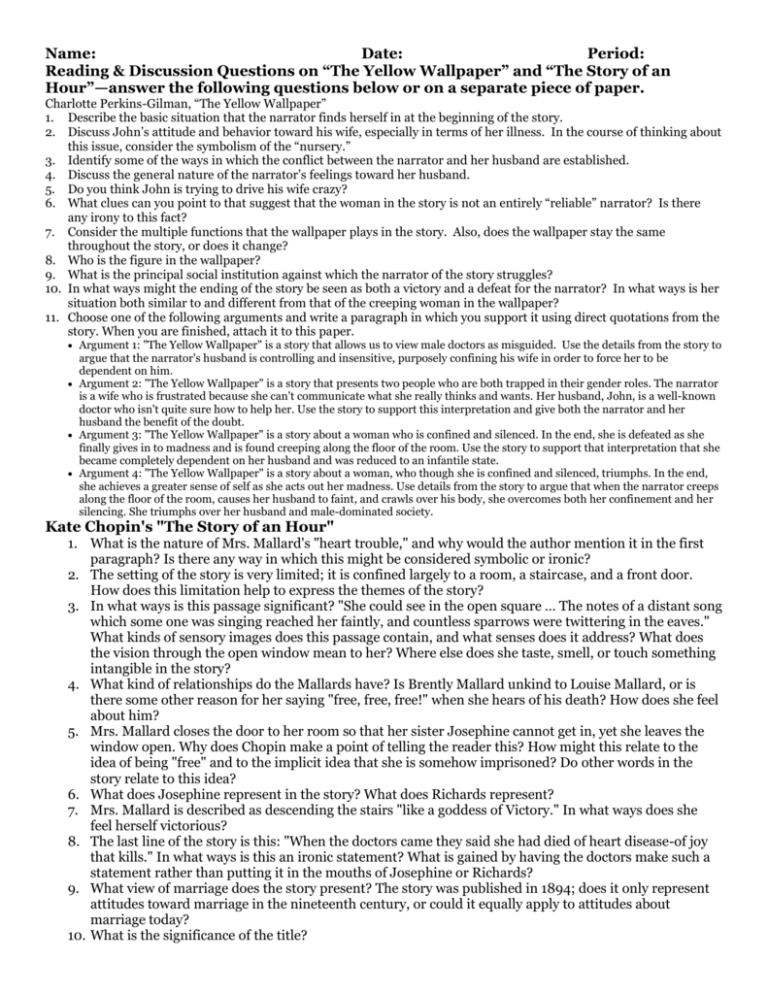
Name: Date: Period: Reading & Discussion Questions on “The Yellow Wallpaper” and “The Story of an Hour”—answer the following questions below or on a separate piece of paper. Charlotte Perkins-Gilman, “The Yellow Wallpaper” 1. Describe the basic situation that the narrator finds herself in at the beginning of the story. 2. Discuss John’s attitude and behavior toward his wife, especially in terms of her illness. In the course of thinking about this issue, consider the symbolism of the “nursery.” 3. Identify some of the ways in which the conflict between the narrator and her husband are established. 4. Discuss the general nature of the narrator’s feelings toward her husband. 5. Do you think John is trying to drive his wife crazy? 6. What clues can you point to that suggest that the woman in the story is not an entirely “reliable” narrator? Is there any irony to this fact? 7. Consider the multiple functions that the wallpaper plays in the story. Also, does the wallpaper stay the same throughout the story, or does it change? 8. Who is the figure in the wallpaper? 9. What is the principal social institution against which the narrator of the story struggles? 10. In what ways might the ending of the story be seen as both a victory and a defeat for the narrator? In what ways is her situation both similar to and different from that of the creeping woman in the wallpaper? 11. Choose one of the following arguments and write a paragraph in which you support it using direct quotations from the story. When you are finished, attach it to this paper. Argument 1: "The Yellow Wallpaper" is a story that allows us to view male doctors as misguided. Use the details from the story to argue that the narrator's husband is controlling and insensitive, purposely confining his wife in order to force her to be dependent on him. Argument 2: "The Yellow Wallpaper" is a story that presents two people who are both trapped in their gender roles. The narrator is a wife who is frustrated because she can't communicate what she really thinks and wants. Her husband, John, is a well-known doctor who isn't quite sure how to help her. Use the story to support this interpretation and give both the narrator and her husband the benefit of the doubt. Argument 3: "The Yellow Wallpaper" is a story about a woman who is confined and silenced. In the end, she is defeated as she finally gives in to madness and is found creeping along the floor of the room. Use the story to support that interpretation that she became completely dependent on her husband and was reduced to an infantile state. Argument 4: "The Yellow Wallpaper" is a story about a woman, who though she is confined and silenced, triumphs. In the end, she achieves a greater sense of self as she acts out her madness. Use details from the story to argue that when the narrator creeps along the floor of the room, causes her husband to faint, and crawls over his body, she overcomes both her confinement and her silencing. She triumphs over her husband and male-dominated society. Kate Chopin's "The Story of an Hour" 1. What is the nature of Mrs. Mallard's "heart trouble," and why would the author mention it in the first paragraph? Is there any way in which this might be considered symbolic or ironic? 2. The setting of the story is very limited; it is confined largely to a room, a staircase, and a front door. How does this limitation help to express the themes of the story? 3. In what ways is this passage significant? "She could see in the open square … The notes of a distant song which some one was singing reached her faintly, and countless sparrows were twittering in the eaves." What kinds of sensory images does this passage contain, and what senses does it address? What does the vision through the open window mean to her? Where else does she taste, smell, or touch something intangible in the story? 4. What kind of relationships do the Mallards have? Is Brently Mallard unkind to Louise Mallard, or is there some other reason for her saying "free, free, free!" when she hears of his death? How does she feel about him? 5. Mrs. Mallard closes the door to her room so that her sister Josephine cannot get in, yet she leaves the window open. Why does Chopin make a point of telling the reader this? How might this relate to the idea of being "free" and to the implicit idea that she is somehow imprisoned? Do other words in the story relate to this idea? 6. What does Josephine represent in the story? What does Richards represent? 7. Mrs. Mallard is described as descending the stairs "like a goddess of Victory." In what ways does she feel herself victorious? 8. The last line of the story is this: "When the doctors came they said she had died of heart disease-of joy that kills." In what ways is this an ironic statement? What is gained by having the doctors make such a statement rather than putting it in the mouths of Josephine or Richards? 9. What view of marriage does the story present? The story was published in 1894; does it only represent attitudes toward marriage in the nineteenth century, or could it equally apply to attitudes about marriage today? 10. What is the significance of the title?
